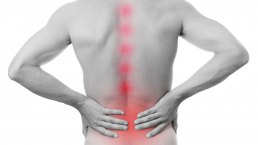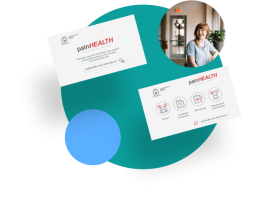Ankylosing Spondylitis
Learn about Ankylosing Spondylitis (AS), current treatments available and get helpful tips to help co-manage Ankylosing Spondylitis
Last updated: 28 Oct 2023 · 7 min read
Ankylosing Spondylitis (AS) is a painful inflammatory rheumatic condition that is characterised by inflammation of structures in the spine. It is part of a group of disorders called Spondyloarthritis – meaning ‘spinal arthritis’. Back pain is one of the main symptoms you have to deal with when managing AS. Back pain related to AS is a ‘specific’ type of back pain and requires a different management approach to ‘non-specific’ back pain, as described in the low back pain condition page.
AS affects a small proportion of the population, estimated at up to 0.5%. The condition is symptomatically more common in men with the disease usually starting at an early age, in the 3rd decade of life. Women are also affected by this condition.
There is a familial link to AS. This means the risk of developing AS is increased if a relative is affected, especially if a gene called HLA B27 is present. HLA B27 can be detected in a blood test. Ask your doctor about this test.
If uncontrolled, ongoing inflammation within the spine and in other musculoskeletal soft tissues and joints can lead to increased bone formation in the spine. Spinal joints become progressively stiffer and ultimately may fuse. This joint stiffening impacts upon the ability to keep your head up and rotate and restricts lower and upper back movement, limiting your ability to move normally and do the things you want to do.
What symptoms and signs suggest Ankylosing Spondylitis?
Inflammation in AS particularly affects the sites at which tendons and/or ligaments join onto bones. The most commonly affected region is the sacroiliac joints: this is where the spine joins onto the pelvis. Symptoms and signs of AS include:
- pain and stiffness in the lower back, buttocks, mid-back or neck
- pain and stiffness typically worse at night or after prolonged rest
- pain and stiffness which improves with activity
- joint pain and swelling, usually in the larger joints
- recurrent or recalcitrant enthesopathy (tendon pain), for example, Achilles tendon pain; tennis elbow (lateral epicondylalgia or extensor tendinopathy); patella (knee cap) tendinopathy; plantar fasciitis (base of heel pain)
- decreased ability to do daily activities including work, home and recreational interests
- fatigue or tiredness
- other organs can also be affected with ongoing inflammation, including the eyes, the skin, the lungs and the gastrointestinal tract
Being diagnosed with Ankylosing Spondylitis
AS is commonly under-recognised in some people suffering with chronic back pain. The delay to diagnosis can be quite long, up to 10 years. The ability to diagnose this condition early is a significant challenge due to poor awareness of this disease and limitations with medical investigations.
If you have concerns about your back pain and think these signs and symptoms are like yours, see your doctor. Your doctor should suspect AS if you list these signs and symptoms. This is what we call ‘a high index of suspicion’ and your doctor can assist with differentiating if your spinal pain is of an inflammatory-type; ie a ‘specific back pain’.
We recommend that you consult your doctor and discuss the potential for further investigations to diagnose AS and to guide your management. Being educated about AS is considered one of the most important current treatment recommendations1. Diagnosing AS early and starting the right treatments at the right time, mean you will have a better outcome and will be better able to manage pain and stay active. See our right care AS Fact Sheet.
Your doctor may refer you to a specialist called a rheumatologist (this is a doctor who specialises in diagnosing and treating arthritis and systemic autoimmune diseases).
Rheumatologists will perform a thorough examination, and work closely with you to educate you about AS. In partnership, you and your specialist will make a decision about your management based on current best evidence recommendations1,2, what you can do (self management), and the role of active non-pharmacological management and the use of appropriate medications for your condition and your pain. Individual or group treatment may be of benefit to you1.
They may also recommend visits to relevant health professionals (such as a physiotherapist). Physiotherapists play an important role in helping people with AS to manage pain and to maintain participation in daily work, home and recreational activities1,2.
Other health professionals may also be part of your team including occupational therapists and dieticians. Occasionally, if pain is hard to manage you may also be referred to a pain medicine doctor. For pain management, you may also be advised to use some medicines2. Visit our medicines and procedures pain management module for further information about pain medicines.
Download our postcard
We've just created a postcard PDF you can download to share with your patients easily.
Why having the right management is so important
If you do have AS, you will need a good management plan that is tailored for you and includes both medicines and other forms of management, in particular, exercise2. Specific medications may be required because control of the excessive inflammation is a very important goal3. Specific medications can help reduce inflammation, pain and stiffness and importantly, will allow you to continue to perform your everyday activities with less limitations. Reduction of inflammation can slow down AS disease progression and prevent excessive damage to your tissues and persistent pain3.
Medications such as non-steroidal anti-inflammatory medications (NSAIDs), Cox-2 inhibitors or biological disease-modifying anti-rheumatic drugs (bDMARDs) are usually required to control AS when the disease is active2,3. For more information on analgesics see medicines and procedures.
Regular exercise is also very important1,2. Exercise helps to keep you moving and doing the things that are important to you. Exercise reduces pain and stiffness, strengthens muscles and joints, helps your brain, heart and lungs, helps to boost your immune system and manages fatigue and sleep. Your exercise program should feature the following components4 :
- joint mobility and stretching exercises (daily)
- postural exercises (daily)
- muscle strengthening exercises for your trunk and limbs and functional strengthening exercises
- aerobic exercise to ensure to meet minimum recommended physical activity guidelines for adults (at least 30min of moderate intensity exercise on 5 days per week).
Specifically prescribed exercise that is tailored to your needs can help you to maintain spinal flexibility, whole body flexibility and to reduce pain. Even when you have pain, learning to exercise in a sensible and graded way has these important benefits. Check out the movement with pain management module to learn more. The combination of the right medication and the right exercise programme may allow you to set new goals once you are able to perform everyday activities with more ease and less pain.
You may also experience low mood with AS or sleep disturbances1. There are effective strategies that you can apply to help you to manage your mood and to assist sleep hygiene1. Practical tips and skills to help manage mood can be found in our pain management modules:
What about symptom 'flare ups'?
There may be times where some of your symptoms are particularly bad: these are called ‘flare ups’. Your spine may feel more painful and stiff than usual. Movement may be difficult and uncomfortable. Sleep may be disrupted. You may develop joint swelling or pain and fatigue. There are a number of things you can do to help manage pain and other symptoms through these pain flares. See our pain management modules including:
It is important that you see your specialist or your doctor as early as possible during a flare. Your doctor or specialist may need to investigate the problem further, change your management or on-refer you to other members of the health team.
Want further information?
For further information about Ankylosing Spondylitis visit Arthritis Australia and Cochrane Summaries. For more information about medicine and Ankylosing Spondylitis, visit the Australian Rheumatology Association website.
If you’re experiencing Ankylosing spondylitis or are concerned about Ankylosing spondylitis, we recommend our Medical Self-Check through our pain self-checks page to help you screen for conditions that may suggest you should consult a Health Professional.
Movement with pain
Pacing and goal setting
Mindfulness and pain
Ankylosing Spondylitis: Promoting wise healthcare
Chronic and Non-Cancer pain management plan
Michael Slater Ankylosing Spondylitis exercises
NAS - Just diagnosed with Ankylosing Spondylitis
Empowered - Arthritis Australia
- Zangi HA, Ndosi M, Adams J, et al. EULAR recommendations for patient education for people with inflammatory arthritis. Annals of the rheumatic diseases 2015; 74(6): 954-62. [PubMed]
- Ward MM, Deodhar A, Gensler L, et al. 2019 Update of the American College of Rheumatology/Spondylitis Association of America/Spondyloarthritis Research and Treatment Network Recommendations for the Treatment of Ankylosing Spondylitis and Nonradiographic Axial Spondyloarthritis. Arthritis Care & Research 2019; 71(10): 1285-1299. [PDF]
- Miedany YE. Treat to target in spondyloarthritis: the time has come. Curr Rheumatol Rev 2015; 10(2): 87-93. [PubMed]
- Millner JR, Barron JS, Beinke KM, et al. Exercise for ankylosing spondylitis: An evidence-based consensus statement. Seminars in Arthritis & Rheumatism 2016; 45(4): 411-427 [PDF]
This module has been developed by Irwin Lim, MBBS; FRACP, Rheumatologist & Director BJC Health, Sydney, Australia; and Errol Lim, BAppSc(Physio), GAICD, Physiotherapist & Director BJC Health, Sydney, Australia.
The information in this module is based on current best evidence research and clinical practice.
SHARE THIS ARTICLE
Pain management information, stories and tips accessible anywhere, anytime.
Access clinically supported practical musculoskeletal pain management information to help you understand pain, how you can manage your pain with your management team on the go on any device.

